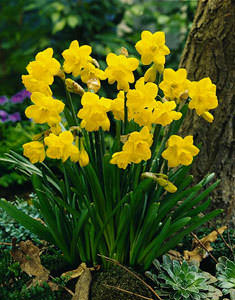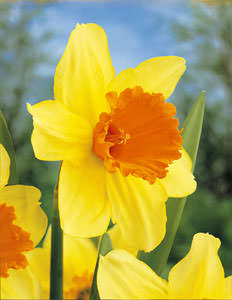| Common name: | Daffodil, narcissus |
| Botanical name: | Narcissus pseudonarcissus |
| Family: | They belong to the larger family Amaryllidaceae which includes bulbs such as Hippeastrum, Nerines, Clivia, Belladonna Lily and Day Lily. One of the oldest forms of daffodils is the Lent Lily, Narcissus pseudonarcissus which grows wild all over Europe's countryside. Its common name probably comes from its flowering at Easter in the northern hemisphere. |
| Origin: | There are about 50 species of narcissus which are native to the Mediterranean. |
| Description: | Strap-shaped leaves coming from the ground. Flowers have inner trumpet/cup-shaped crown surrounded by yellow, white &/orange petals, usually with one flower per stem. Very hardy. |
  |
|
| Uses: | Ornamental flower. Narcissus oil used in perfume manufacture. |
| Allergens: | |
| Allergy: | Although beautiful, daffodils have resulted in severe allergic problems, including death. Symptoms have included allergic rhinoconjunctivitis, asthma, allergic contact dermatitis, irritant contact dermatitis (from contact with narcissus sap) and urticaria. Most patients affected work in the flower industry (bulb growers, stem pickers or florists) but there are reports of reactions from contact with narcissus oil used in fragrances and perfumes. Narcissus contains a number of alkaloids including masonin and homolycorin. These, in conjunction with crystals of calcium oxalate seem to cause the characteristic sores. |
| Cross reactions: | |
| Other information: | Once upon a time . . . in Ancient Greece lived a young man called Narcissus, who was greatly admired, for he was very handsome. Narcissus was very proud of his perfect face and graceful body and never lost the chance to look at his reflection in any sheet of water he happened to pass. He would lie for hours admiring his gleaming dark eyes, slender nose, slim hips and the mop of curly hair that crowned the perfect oval of his face. You would think a sculptor had come down from heaven to carve such a faultless body as a living image of mankind's love of beauty. One day, Narcissus was walking close to a precipice where the clear waters of a cold mountain pool mirrored his beautiful face. "You are handsome, Narcissus!" he told himself as he bent down to admire his reflection. "There's nobody so handsome in the whole world! I'd love to kiss you." Narcissus was suddenly seized by the desire to kiss his own reflection and he leant closer to the water. But he lost his balance and toppled into the pool. Narcissus could not swim and so he drowned. But when the gods discovered that the most beautiful being on earth had died, they decided that such beauty could not be forgotten. The gods turned Narcissus into a scented flower which, to this day, blossoms in the mountains in spring. |
| Patch test: | |